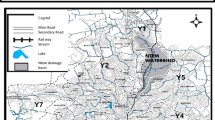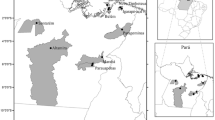Abstract
This study analyses the adsorption of Pb(II) and Cr(III) in soils. These metals are commonly found together in nature in urban wastes or industrial spillages, and the theoretical approach of the work was to evaluate the response of the soil to continuous Cr and Pb spillages to soil in terms of several physicochemical parameters. The influence of an anthropogenic input of phosphorus was evaluated. Continuous flow experiments were run in duplicates in acrylic columns (25 cm × 3.2 cm). The influent Cr(III) and Pb(II) solutions of 10 mg l−1 and 25 mg l−1 at pH 5 were pumped upward through the bottom of the columns to ensure saturation flow conditions. Also, successive experiments were run with the above concentrations of Cr(III) and Pb(II) and NaH2PO4, keeping metal to phosphorus ratio of 1:0, 1:0.1 and 1:1. Modelling parameters included Freundlich and Langmuir equations, together with the Two-site adsorption model using CXTFIT code. Results obtained allowed concluding that Pb(II) adsorption presents a certain degree of irreversibility and the continued spillages over soil increment the fraction which is not easily desorbed. Cr(III) desorption was almost complete, evidencing its high mobility in nature. The presence of an anthropogenic input of phosphorus leads to a marked increase of both Pb(II) and Cr(III) adsorption in soils. Z-potential measurements allow to discard the electrostatic attraction of Cr(III) and Pb(II) with the surface charged soil as the dominant process of metal sorption. Instead, CheaqsPro simulation allows to identify PbH2PO4 +, PbHPO4 (aq) and CrHPO4 + as the dominant species which regulate Cr(III) and Pb(II) transport in soils.





Similar content being viewed by others
References
Altare CR, Bowman RS, Katz LE, Kinney KA, Sullivan EJ (2007) Regeneration and long-term stability of surfactant-modified zeolite for removal of volatile organic compounds from produced water. Microporous Mesoporous Mater 105(3):305–316
Barbosa AE, Hvitved-Jacobsen T (1999) Highway runoff and potential for removal of heavy metals in an infiltration pond in Portugal. Sci Total Environ 235(1–3):151–159
Brusseau ML, Rao PSC (1989) Sorption nonideality during organic contaminant transport in porous media. CRC Crit Rev Environ Control 19:33–99
Declercq I, Cappuyns V, Duclos Y (2012) Monitored natural attenuation (MNA) of contaminated soils: state of the art in Europe-A critical evaluation. Sci Total Environ. doi:10.1016/j.scitotenv.2012.03.040
Devesa-Rey R, Barral MT, Jouanneau J-M, Díaz-Fierros F (2010) Analysis of the degree of contamination and evolution in the last 100 years of the composition of the bed sediments of the Anllóns Basin. Environ Earth Sci 61(7):1401–1417
Dong DM, Zhao XM, Hua XY, Liu JF, Gao M (2009) Investigation of the potential mobility of Pb, Cd and Cr(VI) from moderately contaminated farmland soil to groundwater in Northeast. China. J Hazard Mater 162(2–3):1261–1268
Fang Y, Yabusaki SB, Morrison SJ, Amonette JP, Long PL (2009) Multicomponent reactive transport modeling of uranium bioremediation field experiments. Geochim Cosmochim Acta 73(20):6029–6051
Gadd GM (2000) Bioremedial potential of microbial mechanisms of metal mobilization and immobilization. Curr Opin Biotechnol 11:271–279
Guitián F, Carballas T (1976) Técnicas de Análisis de Suelos. In: Pico Sacro (ed) Santiago de Compostela, Spain, p 288
Hellerich LA, Nikolaidis NP, Dobbs GM (2008) Evaluation of the potential for the natural attenuation of hexavalent chromium within a sub-wetland ground water. J Environ Manag 88:1513–1524
Hendershot WH, Lalande H, Duquette M (1993) Ion exchange and exchangeable cations. In: Carter MR, Gregorich EG (eds) Soil sampling and methods of analysis. CRC Press, Boca Raton, pp 197–206
Kreft A, Zuber A (1978) Physical meaning of dispersion-equation and its solutions for different initial and boundary-conditions. Chem Eng Sci 33:1471–1480
López Periago E, Núnez Delgado A, Díaz-Fierros F (2002) Attenuation of groundwater contamination caused by cattle slurry: a plot-scale experimental study. Bioresour Technol 84(2):105–111
Moore JN, Langner HW (2012) Can a river heal itself? Natural attenuation of metal contamination in river sediment. Environ Sci Technol 46(5):2616–2623
Núñez-Delgado A, López-Períago E, Díaz-Fierros-Viqueira F (2002) Pollution attenuation by soils receiving cattle slurry after passage of a slurry-like feed solution. Column experiments. Bioresour Technol 84(3):229–236
Papelis C (1999) Anion and cation transport in zeolitized tuffs from the Nevada test site: effects on ion type, pH, and ionic strength. In: Selim HM, Sparks DL (eds) Heavy metals release in soils. Lewis Publisher, Boca Raton
Pérez-Novo C, Bermúdez-Couso A, López-Periago E, Fernández-Calviño D, Arias-Estévez M (2009) The effect of phosphate on the sorption of copper by acid soils. Geoderma 150:166–170
Prechthai T, Parkpian P, Visvanathan C (2008) Assessment of heavy metal contamination and its mobilization from municipal solid waste open dumping site. J Hazard Mater 156(1–3):86–94
Quintelas C, Fonseca B, Silva B, Figueiredo H, Tavares T (2009a) Treatment of chromium (VI) solutions in a pilot-scale bioreactor through a biofilm of Arthrobacter viscosus supported on GAC. Bioresour Technol 100:220–226
Quintelas C, Rocha Z, Silva B, Fonseca B, Figueiredo H, Tavares T (2009b) Biosorptive performance of an Escherichia coli biofilm supported on zeolite NaY for the removal of Cr(VI), Cd(II), Fe(III) and Ni(II). Chem Eng J 152(1):110–115
Rose DA, Abbas F, Adey MA (2009) The effect of surface-solute interactions on the transport of solutes through porous materials. Eur J Soil Sci 60(3):398–411
Schwertmann U (1964) Differienzierung der Eisenoxide des Bodens durch Extraktion mit Ammonium Oxalat-Lösung. Z Planzernäh Dung Bodenk 105:194–202
Simpson JA, Bowman RS (2009) Nonequilibrium sorption and transport of volatile petroleum hydrocarbons in surfactant-modified zeolite. J Contam Hydrol 108(1–2):1–11
Strawn DG, Sparks DL (2000) Effects of soil organic matter on the kinetics and mechanisms of Pb(II) sorption and desorption in soil. Soil Sci Soc Am J 64(1):144–156
Summer ME (1999) The electrical double layer and clay dispersion. In: Summer ME, Stewart BA (eds) Soil crusting: chemical and physical process. Lewis Publishers, Boca Raton, FL, pp 1–32
Toride N, Leij FJ, van Genuchten MT (1995) The CXTFIT code for estimating transport parameters from laboratory on field tracer experiments. U.S. Salinity Laboratory, U.S. Department of Agriculture, Riverside, California, p 137
USEPA (1999) Toxic substances hydrology program. Available at: http://toxics.usgs.gov/definitions/natural_attenuation.html
Vázquez G, González-Álvarez J, Garcia AI, Freire MS, Antorrena G (2006) Adsorption of phenol on formaldehyde-pretreated Pinus pinaster bark: equilibrium and kinetics. Bioresour Technol 98:1535–1540
Zhang F, Luo W, Parker JC, Brooks SC, Watson DB, Jardine PM, Gu B (2011) Modeling uranium transport in acidic contaminated groundwater with base addition. J Hazard Mater 190(1–3):863–868
Acknowledgments
The authors gratefully acknowledge both the Portuguese and Spanish financial support from the Fundação para a Ciência e Tecnologia (Portugal) and the Caixa Galicia Foundation (Spain).
Author information
Authors and Affiliations
Corresponding author
Rights and permissions
About this article
Cite this article
Devesa-Rey, R., Fonseca, B., Rubinos, D. et al. Effect of phosphorus on the attenuation of lead and chromium transport in soils. Environ Earth Sci 70, 2443–2451 (2013). https://doi.org/10.1007/s12665-013-2287-1
Received:
Accepted:
Published:
Issue Date:
DOI: https://doi.org/10.1007/s12665-013-2287-1




